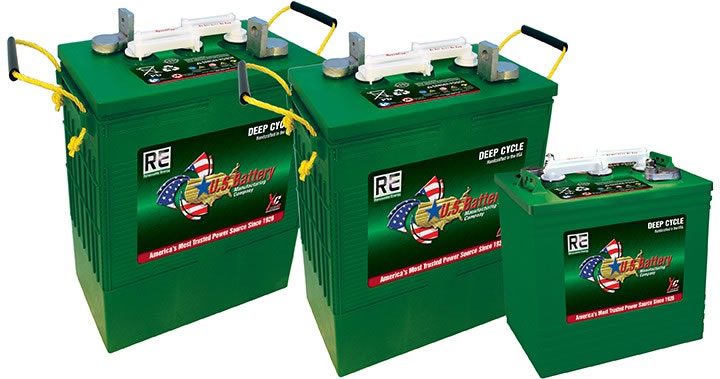Managing Deep-Cycle Batteries For Energy Storage During Stay-At-Home Orders

During a time of stay-at-home and quarantine orders, homes equipped with renewable energy systems will most likely put a strain on the deep-cycle batteries for energy storage. The increase in renewable energy homes and small businesses began as a great way to lower power usage costs, but with more people sequestered in one place using appliances, mobile devices, and other electrical accessories, battery storage systems can suffer if they are not purposely built for energy storage use.
When deep-cycle batteries are discharged too deeply, typically more than 50%, there’s a greater chance of electrolyte stratification to occur. This is a condition where the acid in the electrolyte separates on recharge and collects at the bottom of the battery causing it to become stratified. A battery with stratified electrolyte has an uneven amount of acid at the top and bottom of the cell. This condition can lead to poor performance and short life from increased grid corrosion and plate sulfation. Batteries used in renewable energy and energy storage applications are typically stationary which means they do not benefit from the electrolyte movement and mixing present in vehicular applications. Batteries used in stationary applications require more frequent equalization charging to assure that gassing occurs during charging to mix the electrolyte to prevent electrolyte stratification.
Battery manufacturers with long-term experience in renewable energy markets have developed deep-cycle batteries specifically designed for stationary applications. These batteries have special features designed to prevent failure modes that are prevalent in stationary deep cycle applications. These special design features typically result in higher cost per watt-hour but allow the batteries to last longer in these applications and also allow the battery manufacturers to provide longer warranties in these applications than standard deep cycle batteries. For example, US Battery’s RE line of deep-cycle batteries are made in the US and are designed with features to reduce the effects of mossing and sulfation often encountered in these applications. These include Defender Moss Shields that prevent mossing shorts from reducing performance or even causing an internal short circuit. US Battery’s RE design also includes an Outside Positive (OSP) plate design that provides a better balance of positive and negative active materials to improve charging and resist sulfation and positive grid corrosion. They also have thicker glass mat separators to resist positive active material shedding to increase life.
The following suggestions can help to prevent over-stressing your deep-cycle batteries and provide longer life in energy storage applications:
1) Minimize the depth-of-discharge (DOD) of your batteries to no more than 50%. Discharging deeper than 50% DOD will ultimately shorten the lifespan of your battery pack. If possible, schedule times during the day when certain non-essential items can be turned off. This will help to minimize the depth of discharge.
2) If your renewable energy system is connected to the electrical grid and/or is used in a grid-tie application, schedule charging times to minimize the depth of discharge of the batteries and to take advantage of time-of-day energy cost reductions. Equalization charging can be done at night when energy costs are lower.
3) Some smart charge controllers can be set to perform automatic equalization charging based on battery charge parameters. This can be used to prevent progressive undercharge and sulfation during periods of limited renewable energy availability such as during the winter when sun load is reduced.
4) Check water levels on flooded lead-acid deep-cycle batteries frequently enough to assure the electrolyte levels are always above the plates. Watering should be done only after charging the batteries unless the plates are exposed, then add only enough water to cover the plates. Add additional water as necessary after charging the batteries.
5) Keep the batteries clean and remove any corrosion on terminals and cables. Check battery connections by retightening to proper torque settings monthly. Excess electrolyte and corrosion can be neutralized with a mixture of baking soda and water.
6) Flooded lead-acid batteries charge less efficiently in cold conditions. During the winter months it may take longer for batteries to fully recharge. The best way to ensure the batteries are fully charged and not discharging more than 50% DOD is to use a hydrometer to measure the specific gravity of each battery cell.
When checking specific gravity at extreme temperatures, the readings must be corrected for temperature. Using 80⁰F as a baseline, subtract 0.004 from your hydrometer reading for every 10 degrees below 80⁰F (or every 5.6 degrees below 27 °C). Add 0.004 for every 10 degrees above 80⁰F (or every 5.6 degrees above 27 °C). For example, if the temperature of the electrolyte is 50⁰F and your battery specific gravity reading is 1.200, you must subtract .012 from your measurement. In this case, .004 for every 10-degrees equals .012. Subtract this from 1.200, and your corrected specific gravity reading is 1.188.
Paying closer attention to your renewable energy system’s deep-cycle batteries will ensure they will remain reliable and get you through what could be several weeks or months of having to stay indoors. For more information on deep-cycle batteries manufactured specifically for renewable energy applications, visit www.usbattery.com.
Comments (0)
This post does not have any comments. Be the first to leave a comment below.
Featured Product

